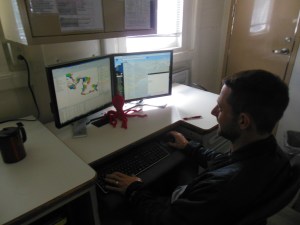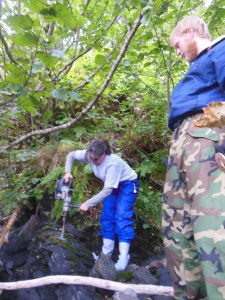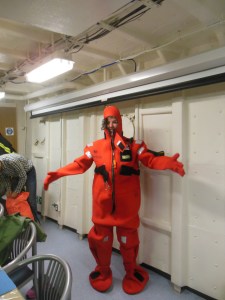NOAA Teacher at Sea
Rebecca Loy
Aboard NOAA Ship Rainier
September 8 – 24 , 2015
Mission: Hydrographic Survey
Geographical area of Research: Kodiak Island, Alaska
Date: September 24, 2015
Current Location: Kodiak, Alaska

While NOAA is a larger organization, I thought it might be nice for people to learn about the group that took such excellent care of me while I was at sea. I am talking about the NOAA Corps. These are the officers that get the ship where it needs to go safely. NOAA Corps is one of the seven uniformed services in the United States. It has a long history starting as Survey of the Coast which was established by Thomas Jefferson in 1807. The 321 officers in NOAA Corps not only work on and operate ships, but they also fly airplanes, facilitate research projects, conduct dive operations and work as staff throughout NOAA.
Press the link to learn more about NOAA Corps. This could lead to an amazing career for someone!
Path to Rainier:
I thought it would be appropriate for me to highlight one of the NOAA officers. They have all been wonderful to me and have taught me so much, it is hard for me to pick just one person. I wish I could highlight them all. One person that I could go to for anything, gave me my tour of Rainier and worked with me on the ship and on the shore is ENS Shelley Devereaux.

The NOAA Corps officers do so much. I enjoyed sitting with ENS Devereaux and learning more about what she does and how she got to Rainier. ENS Devereaux told me she does a little bit of everything, which is very true. She works on navigation, standing watch, logistics of planning details for when the ship is inport including mail delivery and organizing the “liberty van” that takes crew into town. ENS Devereaux does survey work and is the tide assistant (she was with me when we installed the tide gauge earlier). I have only listed a few things here, all of the officers work very hard and are pretty amazing people!
ENS Devereaux started as a math major in college. She also did some work as a bicycle mechanic, a pastry chef, worked as a research assistant for a bio lab and was a data manager for an educational non-profit. She realized she missed science and went back to school to get her Master’s Degree in Geographic Information Systems. She studied mapping applied to many areas of study including data visualization.
She learned about NOAA Corps when her uncle told her and her cousin about it. ENS Devereaux’s cousin applied first and then she followed. Her cousin in on Rainier’s sister ship, Fairweather. Interestingly, the two cousins had a chance to meet up this past summer in the Arctic.

ENS Devereaux told me more about the NOAA Corps. She had to undergo training for 6 months with the Coast Guard Academy (the two services work together for training). There she learned ship navigation, firefighting, First Aid, driving the rescue boats and how to be an officer plus much more. After her initial training, she had further training with NOAA for safety, teamwork, communication, leadership skills and problem solving. ENS Devereaux truly enjoys the hands on work, being part of a team, serving and creating charts for safe navigation.
When I asked ENS Devereaux where she has been in the world, she told me she traveled to parts of Europe and Costa Rica, but the most interesting part is she backpacked by herself through Mongolia, China and Taiwan. I was not surprised that this dynamic woman would take on this challenge.

Like all of the officers on Rainier, ENS Devereaux is a pretty spectacular person. Knowing that people like her, including her NOAA Corps colleagues, are serving and taking care of our oceans is very reassuring. Thank you for everything you have done for me and our planet.
Personal Log:


My time here on Rainier is drawing to a close. When I first arrived, it was all so new and exciting and I must admit it was a bit overwhelming. Now, almost 3 weeks later, I feel like an integral part of this crew. While this ship is incredible, it is the people who make it their work and home that make it truly special.
This hard working crew has included me in everything! I was given every opportunity possible so I could bring this experience back to my community – and I have some wonderful ideas thanks to them!!!

I learned more than just how this ship runs or what hydrographic surveys are. More importantly, I watched this group of people be problem solvers. We often teach our students how to resolve a situation. Being on Rainier showed me that this is a skill that needs to continually be exercised!

I appreciated how a situation would present itself and the crew would move into action! This could be something less intense like planning our route from bay to bay around Kodiak Island to more involved problem solving such as repairs/maintenance to the MVP on the back of the ship. A group of people would start thinking, brainstorming, testing, reviewing and thinking some more. They came together from different departments and areas of expertise to solve an issue. It was incredible to be a part of this process and something I plan to facilitate more in my teaching.


I have the greatest respect for this unique group of people. I am going to miss a lot here… the easy comradery they have with each other, sharing our wish for better internet among the mountains, looking for wildlife or the aurora borealis together, eating PB&J sandwiches with the most incredible views, having dessert with lunch AND dinner, 18:00 movie time (6:00 PM for those of you on shore), watching the beautiful Alaskan coast go by, whales…whales and more whales, the unique names that are used throughout the ship (the Holodeck, Princess Suite, engineer Hollywood just to name a few), line handling and all kinds of deck work, learning how to use a crane and not getting the Bo’sun wet, watching the launches come out of and into their cradles, hanging on to EVERYTHING as the ship rolls and pitches (yes, even this), looking at ENS Kosten and ENS Devereaux’s beautiful photos, hearing about everyone’s incredible experiences- especially in the Arctic, bumping my head in engineering, and most importantly, being my nerdy self with people who understand!
I am very thankful to NOAA ship Rainier Commanding Officer EJ Van Den Ameele for being so kind and allowing me this opportunity, to Rainier’s officers and crew for being so helpful and supportive as I learned my way around asking a million and one questions (no joke, I should have kept track of how many I asked) and to the NOAA Teacher at Sea program.
I hope to make you all proud as I head back home and share this incredible experience!




































































